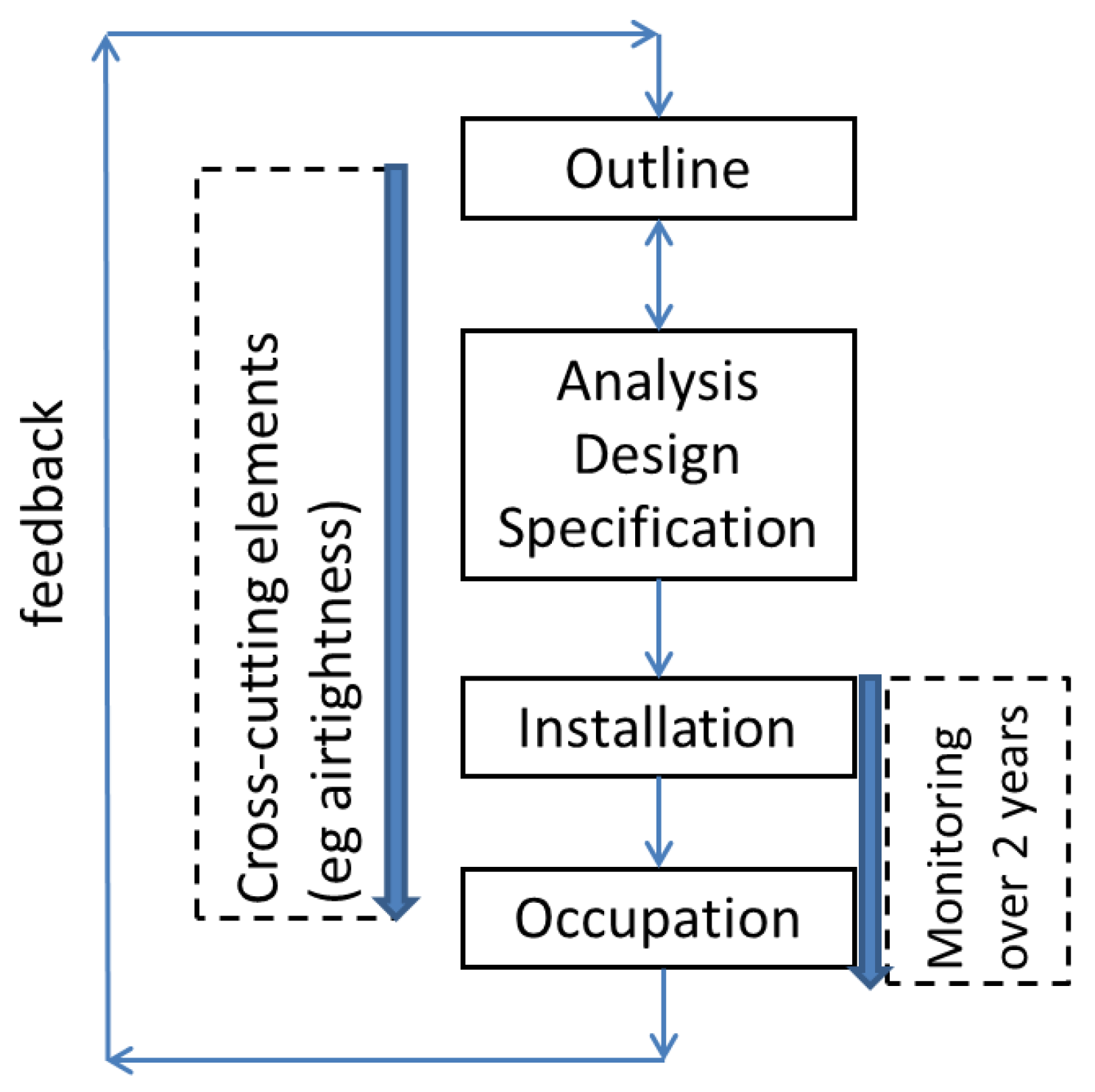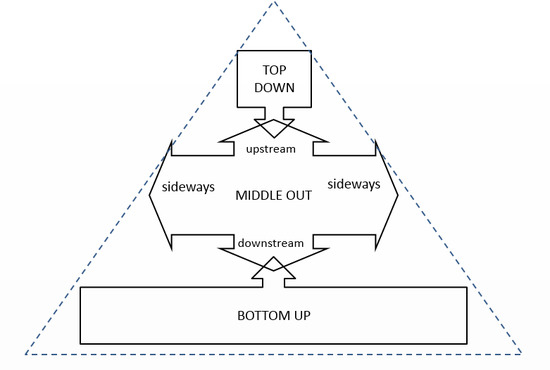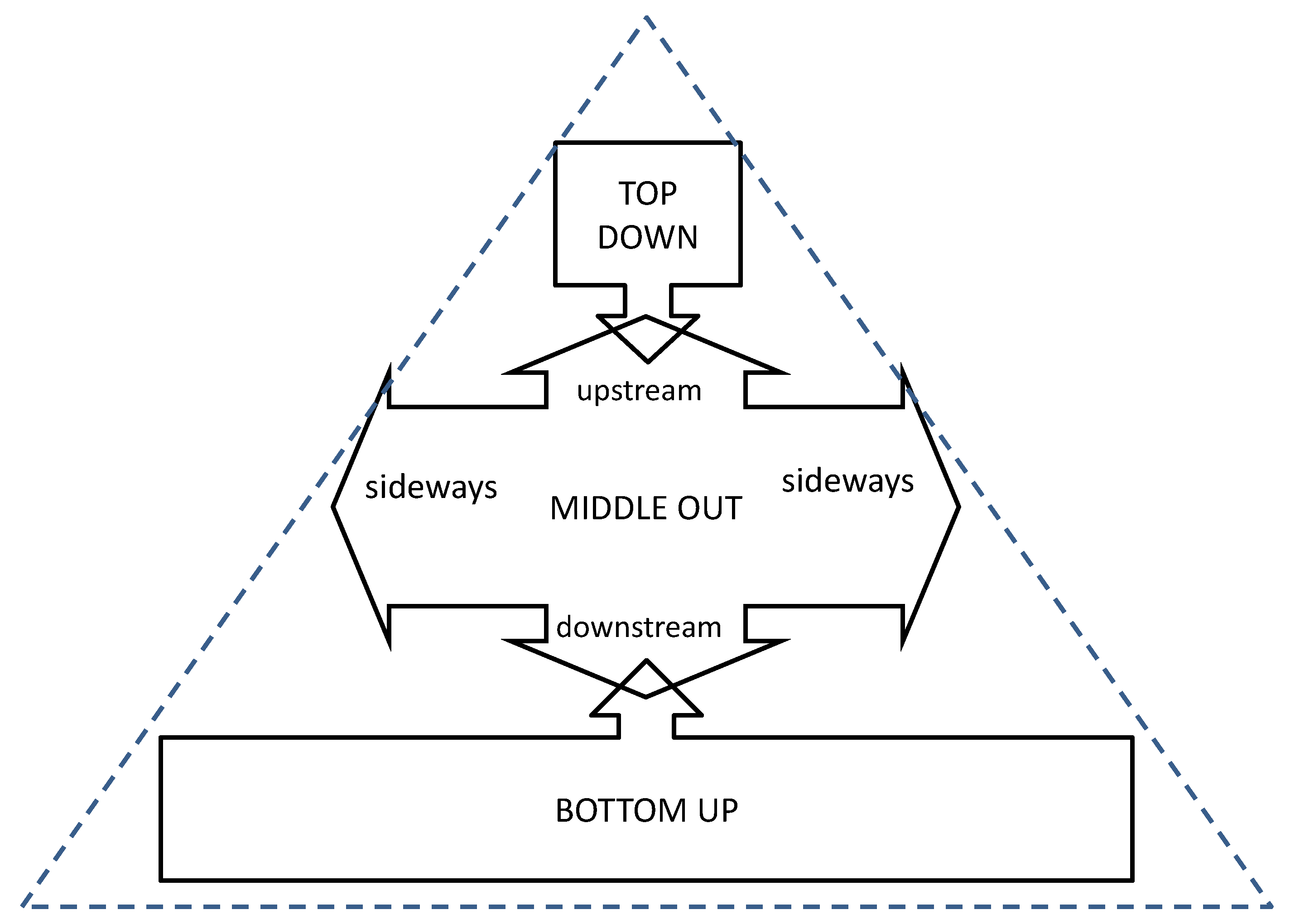Reducing Carbon from the “Middle-Out”: The Role of Builders in Domestic Refurbishment †
Abstract
:1. Introduction
2. Research Approach
2.1. Why These Countries?
2.2. Theory and Application
2.3. Methodology and Methods
| France | UK |
|---|---|
| Case F1: | Case UK1: |
Cooperative Retrofit Company—Energy Performance Guarantee
| Large Social Landlord—Retrofit Work Force Innovation
|
| Case F2: | Case UK2: |
Small business—Integrated Approach to Retrofit Project Management
| Microbusiness—Brokering Scheme for Green Deal
|
3. Innovative Renovation in Professional Practice: France
3.1. Macro Level: French Eco-Renovation Policy Framework
- High-performance roof insulation;
- High-performance wall insulation;
- High-performance windows and doors;
- Installation or replacement of a system for space heating or hot water;
- Installation of thermal renewable energy technologies for space heating;
- Installation of thermal renewable energy technologies for water heating.
3.2. Meso Level: French Building Industry Practices and Innovations
3.3. Micro Level: Case Studies in France
3.3.1. Case F1: Retrofit with Energy Performance Guarantee
3.3.2. Case F2: Integrated Approach to Retrofit Project Management
“Each project is unique. Clients tend to think a renovated building is like a new car, with everything working perfectly and all you have to do is turn the key and off you go. But it’s never like that. For any big or medium-sized project you need at least two years for monitoring, adjusting, optimising. And that’s the thing that no-one does, that no-one has responsibility for. No-one is willing to pay for it.”

4. Innovative Renovation in Professional Practice: UK
4.1. Macro Level: UK Eco-Renovation Policy Framework
4.2. Meso Level: UK Building Industry Practices and Innovations
4.3. Micro Level: Building Expertise Case Studies in UK
4.3.1. Case UK1: Social Landlord Retrofit Work Force Innovation
“It’s like any couple, one person in the couple is more domineering, they like taking charge of doing that. When you work in a team, you know they’re going to go and do that side and you’ll do this, whereas if you get a new team, you’re both wary of each other, what’s he going to want to do, what am I going to want to do” (#28).
4.3.2. Case UK2: Brokering Scheme for Green Deal
- Ability to control budgets;
- Good understanding of design;
- Very wide but shallow knowledge (with recourse to specialist assistance when necessary);
- Good people management skills (“getting people to do stuff that they don’t really want to do necessarily”).
- efficient organisation of resources, for example communicating with other contractors to make best use of scaffolding;
- being a responsible professional, doing things that will help other trades who follow, or communicating with those who go before so that the hand-over from one person to the next is efficient.
“I actually think [the brokering scheme] will do more work outside the Green Deal than inside […] but the Green Deal is the current panic that will get everybody joined up. […] in other words most of the homeowners who [use the brokering scheme] won’t need the Green Deal finance. I think they just want good contractors who understand eco stuff […] they just want a good supply chain. They want an assessment done.”
5. Discussion: British and French Builders as Middle Actors
| France | UK |
|---|---|
| Case F1: | Case UK1: |
Cooperative Retrofit Company—Energy Performance Guarantee
| Large Social Landlord—Retrofit Work Force Innovation
|
| Case F2: | Case UK2: |
Small business—Integrated Approach to Retrofit Project Management
| Microbusiness—Brokering Scheme for Green Deal
|
5.1. Upstream Influences: Implications for Policy
5.2. Downstream Influences: Implications for Customers
5.2.1. Low-Carbon Refurbishment as “Up-Selling”
5.2.2. Low Carbon Refurbishment and Behavioural Control
5.3. Sideways Influences: Implications for Builders and Building Professionals
5.3.1. The Organisation of Project-Based Work
5.3.2. Vocational Education and Training
5.3.3. Professional Boundaries: Responsibility and Integration
6. Conclusions and Further Research
Acknowledgments
Author Contributions
Conflicts of Interest
References
- Energy Efficiency in Building—Transforming the Market; World Business Council for Sustainable Development (WBCSD): Geneva, Switzerland, 2009; p. 72.
- Eurostat. Consumption of Energy. Available online: http://epp.eurostat.ec.europa.eu/statistics_explained/index.php/Consumption_of_energy (accessed on 29 September 2014).
- Energy Consumption in the UK; URN: 14D/208; Department of Energy and Climate Change (DECC): London, UK, 2014.
- Energy Efficiency Policies and Measures in France; Agence de l'Environnement et de la Maîtrise de l' Énergie (ADEME): Paris, France, 2012. Available online: http://www.odyssee-mure.eu/publications/national-reports/energy-efficiency-france.pdf (accessed on 29 September 2014).
- Climate Change Act; Her Majesty’s Government: London, UK, 2008.
- Loi n° 2009–967 du 3 Août 2009 de Programmation Relative à la Mise en Œuvre du Grenelle de Lenvironnement; French Government: Paris, France, 2009. (In French)
- Loi n° 2010–788 du 12 Juillet 2010 Portant Engagement National Pour L’environnement; French Government: Paris, France, 2010. (In French)
- Sustainable Refurbishment; CE309; Energy Saving Trust (EST): London, UK, 2010.
- Horne, R.; Dalton, T. Transition to low carbon? An analysis of socio-technical change in housing renovation. Urban Stud. 2014. [Google Scholar] [CrossRef]
- Eames, M.; Dixon, T.; Lannon, S.; Hunt, M.; de Laurentis, C.; Marvin, S.; Hodson, M.; Guthrie, P.; Georgiadou, M.C. Retrofit 2050: Critical Challenges for Urban Transitions; Cardiff University: Cardiff, UK, 2014. [Google Scholar]
- Fawcett, T.; Killip, G.; Janda, K.B. Building Expertise: Identifying Policy Gaps and New Ideas in Housing Eco-Renovation in the UK and France. In Proceedings of the ECEEE Summer Study, Presqu'île de Giens, France, 3–8 June 2013; pp. 339–350.
- Janda, K.B.; Killip, G. Building Expertise: Renovation as Professional Innovation. Constructing Green: The Social Structures of Sustainability 2013, 35–55. [Google Scholar]
- Killip, G.; Fawcett, T.; Janda, K.B. Innovation in low-energy home renovation in the UK and France. Proc. ICE Energy 2014, 167, 117–124. [Google Scholar] [CrossRef]
- Fawcett, T.; Killip, G. Anatomy of low carbon retrofits: Evidence from owner-occupied superhomes. Build. Res. Inf. 2014, 42, 434–445. [Google Scholar] [CrossRef]
- Guy, S.; Shove, E. A Sociology of Energy, Buildings, and the Environment; Routledge: London, UK, 2000. [Google Scholar]
- Schiellerup, P.; Gwilliam, J. Social production of desirable space: An exploration of the practice and role of property agents in the uk commercial property market. Environ. Plan. C Gov. Policy 2009, 27, 801–814. [Google Scholar] [CrossRef]
- Hill, S.; Lorenz, D. Rethinking professionalism: Guardianship of land and resources. Build. Res. Inf. 2011, 39, 314–319. [Google Scholar] [CrossRef]
- Killip, G. Building a Greener Britain: Transforming the UK’s Existing Housing Stock; Environmental Change Institute: Oxford, UK, 2008. [Google Scholar]
- Killip, G. Implications of an 80% CO2 Emissions Reduction Target for the UK Housing Refurbishment Industry; University of Oxford: Oxford, UK, 2011. [Google Scholar]
- Janda, K.B. Building Change: Effects of Professional Culture and Organizational Context on Energy Efficiency Adoption in Buildings. Ph.D. Dissertation, University of California at Berkeley, Berkeley, CA, USA, 1998. [Google Scholar]
- Janda, K.B. Re-Inscribing Design Work: Architects, Engineers, and Efficiency Advocates. In Proceedings of the European Council for an Energy Efficient Economy (ECEEE) Summer Study, Mandelieu, France, 1–6 June 1999.
- Janda, K.B.; Parag, Y. A middle-out approach for improving energy performance in buildings. Build. Res. Inf. 2013, 41, 39–50. [Google Scholar] [CrossRef]
- Parag, Y.; Janda, K.B. More than filler: Middle actors and socio-technical change in the energy system from the “middle-out”. Energy Res. Soc. Sci. 2014, 3, 102–112. [Google Scholar] [CrossRef]
- Anderson, R. Introduction to Part Three: Accessing Information. In Cross-National Research Methods in the Social Sciences; Hantrais, L., Mangen, S., Eds.; Pinter: London, UK, 1996; pp. 105–108. [Google Scholar]
- Abbott, A. The System of Professions; University of Chicago Press: Chicago, IL, USA, 1988. [Google Scholar]
- Bijker, W.E.; Hughes, T.P.; Pinch, T. The Social Construction of Technological Systems; Massachusetts Institute of Technology Press: Cambridge, MA, USA, 1987. [Google Scholar]
- Hughes, T.P. The seamless web: Technology, science, etcetera, etcetera. Soc. Stud. Sci. 1986, 16, 281–292. [Google Scholar] [CrossRef]
- Nösperger, S.; Killip, G.; Janda, K.B. Building Expertise: A System of Professions Approach to Low-Carbon Refurbishment in the UK and France. In Proceedings of the ECEEE Summer Study, Belambra Presqu'île de Giens, France, 6–11 June 2011.
- Killip, G.; Fawcett, T.; Janda, K.B. Building Expertise: Industry Responses to the Low-Energy Housing Retrofit Agenda in the Uk and France. In Proceedings of the ECEEE Summer Study, Presqu'île de Giens, France, 3–8 June 2013.
- Unruh, G.C. Understanding carbon lock-in. Energy Policy 2000, 28, 817–830. [Google Scholar] [CrossRef]
- Killip, G. Products, practices and processes: Exploring the innovation potential for low-carbon housing refurbishment among small and medium-sized enterprises (SMEs) in the UK construction industry. Energy Policy 2013, 62, 522–530. [Google Scholar] [CrossRef]
- Barrett, P.; Abbott, C.; Sexton, M.; Ruddock, L. Hidden Innovation in the Construction and Property Sectors; Royal Institute of Charterd Surveyors (RICS): London, UK, 2007; pp. 1–21. [Google Scholar]
- Taylor, J.E.; Levitt, R.E. Inter-Organizational Knowledge Flow and Innovation Diffusion in Project-Based Industries; CIFE Working Paper #089; Stanford University: Stanford, CA, USA, 2005. [Google Scholar]
- Taylor, J.E.; Levitt, R.E. A New Model for Systemic Innovation Diffusion in Project-Based Industries; Stanford University: Palo Alto, CA, USA, 2010. [Google Scholar]
- Scott, W.R.; Levitt, R.E.; Orr, R.J. Global Projects: Institutional and Political Challenges; Cambridge University Press: Cambridge, UK, 2011. [Google Scholar]
- Yin, R.K. Case Study Research; Sage Publications: Beverly Hills, CA, USA, 1984; Volume 5. [Google Scholar]
- King, G.; Keohane, R.O.; Verba, S. Designing Social Inquiry: Scientific Inference in Qualitative Research; Princeton University Press: Princeton, NJ, USA, 1994; p. 245. [Google Scholar]
- Putnam, R.D. Making Democracy Work; Princeton University Press: Princeton, NJ, USA, 1993. [Google Scholar]
- Ragin, C.C. Introduction. In What Is a Case: Exploring the Foundations of Social Inquiry; Ragin, C.C., Becker, H.S., Eds.; Cambridge University Press: New York, NY, USA, 1992; pp. 1–17. [Google Scholar]
- Pouget Consultants. Le defi: Isoler Par l’intérieur en Site Occupé. (In French)Available online: http://www.pouget-consultants.fr (accessed on 27 July 2014).
- United House. Whole House In-Situ Carbon and Energy Reduction solution (WHISCERS). Available online: http://www.unitedhouse.net/refurbishment/whiscers (accessed on 26 October 2014).
- UKERC & SDC. Unlocking Energy Services: Main Findings of a Joint SDC/UKERC Seminar. Available online: http://www.ukerc.ac.uk/Downloads/PDF/E/ESCOs_final_report_FINAL.pdf (accessed on 26 October 2014).
- The Green Deal and Energy Company Obligation: Consultation Document; Department of Energy and Climate Change (DECC): London, UK, 2011.
- The Green Deal: A Summary of the Government’s Proposal.; Department of Energy and Climate Change (DECC): London, UK, 2010.
- Feed-in Tariffs Scheme: Government Response to Consultation on Comprehensive Review Phase 1—Tariffs for Solar Pv; URN 12D/005; Department of Energy and Climate Change (DECC): London, UK, 2012.
- Latham, R. Constructing the Team: Final Report of the Government/Industry Review of Procurement and Contractural Arrangements in the UK Construction Industry; Her Majesty’s Stationery Office: London, UK, 1994. [Google Scholar]
- Egan, J. Rethinking Construction; Department of Trade and Industry: London, UK, 1998; pp. 1–38. [Google Scholar]
- Egan, J. Accelerating Change; Strategic Forum for Construction: London, UK, 2002; pp. 1–44. [Google Scholar]
- Wolstenholme, A.; Austin, S.; Bairstow, M.; Blumenthal, A.; Lorimer, J.; Rhys Jones, S.; Ward, D.; Whysall, D.; le Grand, Z.; Guthrie, W.; et al. Never Waste a Good Crisis: A Review of Progress Since Rethinking Construction and Thoughts for our Future; Constructing Excellence: London, UK, 2009; pp. 1–32. [Google Scholar]
- Thaler, R.; Sunstein, C.R. Nudge: Improving Decisions about Health, Wealth, and Happiness; Yale University Press: New Haven, CT, USA, 2008. [Google Scholar]
- Benedictus, L. The Nudge Unit—Has it Worked So Far? The Guardian 2013. [Google Scholar]
- Which? The Green Deal Explained. Available online: http://www.which.co.uk/energy/creating-an-energy-saving-home/guides/the-green-deal-explained/green-deal-finance-paying-for-the-green-deal/ (accessed on 29.September 2014).
- Superhomes. Opening Doors to Low Energy Refurbishment. Available online: http://www.superhomes.org.uk (accessed on 26 October 2014).
- Killip, G. Transition management using a market transformation approach: Lessons for theory, research, and practice from the case of low-carbon housing refurbishment in the UK. Environ. Plan. C Gov. Policy 2013, 31, 876–892. [Google Scholar] [CrossRef]
- Fawcett, T.; Mayne, R. Exploring an “Over Time” Model of Eco-Renovation. In Retrofit 2012; University of Salford: Salford, UK, 2012. [Google Scholar]
- Killip, G. Latent Market Opportunities for Low-Carbon Housing Refurbishmen. In Energy and People: Futures, Complexity and Challenges; Environmental Change Institute: Oxford, UK, 2011. [Google Scholar]
- Trigger Points: A Convenient Truth; Energy Saving Trust (EST): London, UK, 2011.
- Dainty, A.R.J.; Green, S.; Baglihole, B. People and Culture in Construction: Contexts and Challenges. In People and Culture in Construction: A Reader; Dainty, A.R.J., Green, S., Baglihole, B., Eds.; Taylor & Francis: Abingdon, UK, 2007; pp. 3–25. [Google Scholar]
- Energy Efficiency in Buildings: Business Realities and Opportunities; World Business Council for Sustainable Development (WBCSD): Geneva, Switzerland, 2007.
© 2014 by the authors; licensee MDPI, Basel, Switzerland. This article is an open access article distributed under the terms and conditions of the Creative Commons Attribution license (http://creativecommons.org/licenses/by/4.0/).
Share and Cite
Janda, K.B.; Killip, G.; Fawcett, T. Reducing Carbon from the “Middle-Out”: The Role of Builders in Domestic Refurbishment. Buildings 2014, 4, 911-936. https://doi.org/10.3390/buildings4040911
Janda KB, Killip G, Fawcett T. Reducing Carbon from the “Middle-Out”: The Role of Builders in Domestic Refurbishment. Buildings. 2014; 4(4):911-936. https://doi.org/10.3390/buildings4040911
Chicago/Turabian StyleJanda, Kathryn B., Gavin Killip, and Tina Fawcett. 2014. "Reducing Carbon from the “Middle-Out”: The Role of Builders in Domestic Refurbishment" Buildings 4, no. 4: 911-936. https://doi.org/10.3390/buildings4040911






